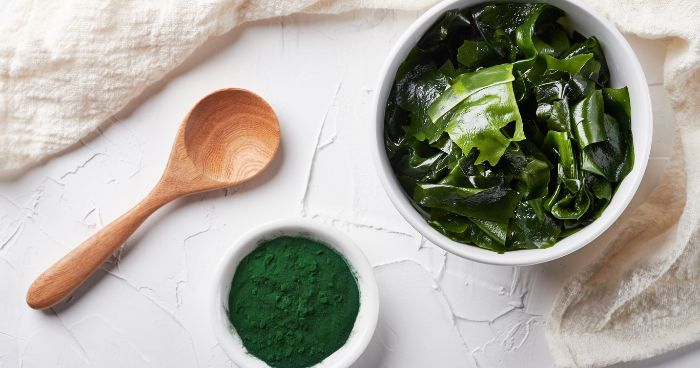Ever taken a sip of matcha and thought, Why does matcha taste like seaweed? Trust me, you’re not alone in this green tea mystery! Matcha, with its vibrant hue and distinct flavor, often leaves newbies wondering if they accidentally scooped up some seaweed instead. But don’t worry, your matcha hasn’t taken a wrong turn at the sushi bar. Let’s unravel the magic behind this oceanic twist and dig into why matcha tastes like a splash of the sea.
The Umami Factor
Alright, hold your ears, because we’re diving into the savory world of umami! Umami is that mouth-watering, savory flavor that makes your taste buds do a happy dance. It’s the secret weapon in everything from soy sauce to Parmesan cheese – and yes, our beloved matcha.
What is Umami?: Umami is Japanese for “pleasant savory taste,” and it’s like the flavor equivalent of a warm hug. It’s that deep, satisfying taste that makes you go, “Mmm, more please!”
Matcha’s Umami: In matcha, this umami magic comes from amino acids, especially L-theanine and glutamic acid. These little flavor ninjas are naturally found in green tea leaves, particularly those grown in the shade like matcha. The shading process boosts these amino acids, resulting in that rich, savory goodness.
Connection to Seaweed: Here’s the kicker – seaweed is also packed with glutamic acid, which is why matcha and seaweed share that umami flavor. When you sip on matcha and think, “Whoa, this tastes like the ocean,” it’s those amino acids doing their thing. It’s like your taste buds are getting a savory hug from nature.
Chlorophyll Content
Now let’s talk green – no, not cash, but chlorophyll! This green pigment is the powerhouse behind matcha’s vibrant color and unique taste.
Shaded Growth Process: Matcha tea plants are treated like royalty. They’re shaded for about three weeks before harvest, which cranks up their chlorophyll production. It’s like giving them a spa day, but for three weeks straight. This shading makes the leaves rich in nutrients and that beautiful green color.
Impact on Flavor: Chlorophyll isn’t just a pretty face; it packs a flavor punch too. It gives matcha that fresh, grassy, and slightly sweet taste. Think of it as the green goodness that makes matcha taste, well, green.
Comparison to Seaweed: Seaweed is also high in chlorophyll, which explains why both share that earthy, oceanic flavor. When you drink matcha, you’re essentially tasting the concentrated essence of green plants, just like when you enjoy seaweed. It’s nature’s way of saying, “Here’s a taste of the earth and sea in one sip.”
Terroir and Cultivation
Let’s go on a little trip to Japan’s lush tea fields, where the magic of matcha begins. The flavor of matcha is like a love letter from its environment – the terroir.
Influence of Soil and Environment: Matcha gets its unique taste from the rich, volcanic soil of places like Uji and Kagoshima. This soil is packed with minerals, making the tea plants super nutrient-rich. It’s like matcha plants are growing in a five-star resort, absorbing all the good stuff.
Role of Sea Breezes: Many of Japan’s top matcha-growing regions are close to the sea. The cool, salty air from the ocean breezes over the tea fields, creating the perfect climate. This not only helps regulate temperature and humidity but also infuses a subtle marine note into the tea leaves. So, when you taste that hint of seaweed, it’s the sea’s little gift to your matcha.
Processing Techniques
Alright, let’s get into the nitty-gritty of how matcha is made. Spoiler alert: It’s a meticulous process that’s all about preserving flavor and quality.
Steaming and Grinding: After harvesting, matcha leaves (called tencha) are steamed to prevent oxidation. This step is crucial because it locks in that fresh, grassy flavor and boosts the chlorophyll content. Then, the leaves are dried, de-veined, and ground into a fine powder using traditional granite stone mills. This slow grinding process ensures a smooth texture and rich flavor.
Comparison to Seaweed Processing: Just like matcha, seaweed is carefully processed to retain its flavor and nutrients. Seaweed is typically harvested, rinsed, and dried quickly. This drying process, similar to steaming matcha, helps preserve its fresh, oceanic taste. Both matcha and seaweed are treated with the utmost care to maintain their unique flavors.
Amino Acids and Catechins
Now, let’s talk about the dynamic duo in your matcha cup – amino acids and catechins. These compounds are the secret sauce behind matcha’s health benefits and its distinct taste.
Health Benefits: Amino acids, especially L-theanine, are like your matcha’s personal zen master. They promote relaxation, reduce stress, and boost brain function, making you feel calm yet alert. Catechins, particularly EGCG, are powerful antioxidants that protect your body from damage, reduce inflammation, and even help with weight management. It’s like having a health spa in every cup.
Flavor Profile: L-theanine gives matcha its umami flavor, that savory taste that makes you think of seaweed. Catechins add a touch of astringency and slight bitterness, balancing out the sweet and savory notes. This complex interplay of flavors makes matcha a unique taste adventure, giving you a rich, satisfying sip every time.
Conclusion
So, why does matcha taste like seaweed? It’s a delightful mix of umami-packed amino acids, chlorophyll from shaded growth, the rich terroir of Japan’s tea fields, meticulous processing, and the powerful duo of amino acids and catechins. Next time you sip your matcha, savor the journey from leaf to cup and appreciate the oceanic twist that makes it so special. Cheers to the green magic that is matcha!


